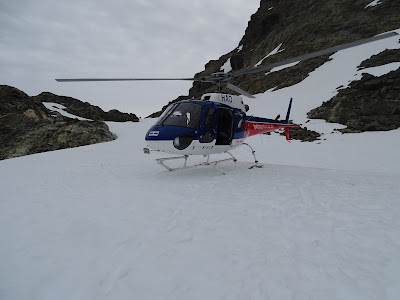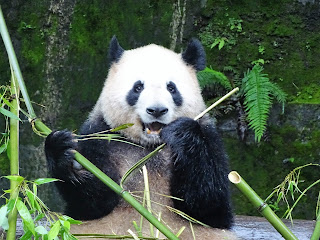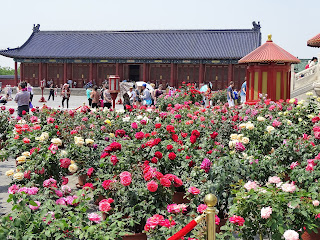The Travel Leaders International Summit was being held in Shanghai this year and these summits have become the highlight of my year having attended 6 out of the last 7 in various cities around the world. After visiting Cambodia and Vietnam last summer on a Avalon river cruise down the Mekong, I couldn't wait for my return trip to Asia. The last time I was in China was in 1988 and I knew I was in for a special treat. As you can imagine things have changed dramatically in China over the last 28 years. The last time I was there it was very difficult for foreigners to even be allowed into the country and now tourism is becoming a huge industry for them.
I arrived in Shanghai on Wednesday May 11th and checked into my hotel for the next 4 days at the Jing An Shangri-La Hotel in the western upscale district of Jing An. The Shangri-La Hotels are five star luxury properties and I had previously stayed in the one in Istanbul and loved it. Shanghai began as a simple seaside fishing village and during the Yuan Dynasty in 1291 it achieved Country status and by the 1930's it had developed into the most important shipping port in all of Asia. In recent years, Shanghai has become one of Asia's financial centers and one of the largest cities in the world. It is now the busiest container port in the world.
 On Thursday morning we took a tour of the M50 Art District which has many galleries and studios that are mostly situated in warehouses. There are 100's of artist who not only sell their art here but they also work and live here. I would say most of the art is contemporary but with a Chinese or Asian flair. After lunch, we proceeded to the Bund District which is on the Shanghai waterfront. On one side of the Yangtze tributary called the Huangpu River are the older historic buildings that were built by UK, US, French, Italian and Russians prior to the Communist regime and on the other side of the river is the Pudong District which is completely made up of modern skyscrapers that were built after 1992. We were lucky this afternoon as we got to tour the Shanghai Tower which is brand new and isn't open to the public yet. The Shanghai Tower is the second tallest building in the world at 137 stories. The observatory is on the 118th - 120th stories and has a spectacular view. In the Bund District on the other side of the river there are restrictions on the height of the buildings. On Thursday night we had our Travel Leaders Welcome Reception and Dinner at the Shangri-La on the 55th floor.
On Thursday morning we took a tour of the M50 Art District which has many galleries and studios that are mostly situated in warehouses. There are 100's of artist who not only sell their art here but they also work and live here. I would say most of the art is contemporary but with a Chinese or Asian flair. After lunch, we proceeded to the Bund District which is on the Shanghai waterfront. On one side of the Yangtze tributary called the Huangpu River are the older historic buildings that were built by UK, US, French, Italian and Russians prior to the Communist regime and on the other side of the river is the Pudong District which is completely made up of modern skyscrapers that were built after 1992. We were lucky this afternoon as we got to tour the Shanghai Tower which is brand new and isn't open to the public yet. The Shanghai Tower is the second tallest building in the world at 137 stories. The observatory is on the 118th - 120th stories and has a spectacular view. In the Bund District on the other side of the river there are restrictions on the height of the buildings. On Thursday night we had our Travel Leaders Welcome Reception and Dinner at the Shangri-La on the 55th floor.

After our Travel Leaders Business Meeting on Friday morning, we had lunch at the Lost Heaven Restaurant. The lunch was delicious and we sampled many different types of Chinese cuisine. After lunch, we had a motorcycle side car tour of some of the different districts in Shanghai.
On Friday evening, we did a Huangpu River Cruise. The weather was a little overcast and foggy but it was still beautiful and the night lights of all the buildings were stunning. Beginning from the wharf at the Bund, we cruised by the ultra modern Pudong District and all the old historical buildings on the Bund. The light displays on the skyscrapers were unbelievable.
On Saturday we had an all day trip to Tongli Water Village which is about a 2 hour drive from Shanghai to the outskirts of Suzhou in the Jiangsu District. Tongli is known for its system of canals and has been nicknamed the "Venice of the East." Tongli has many attractions which includes the famous Retreat and Reflection Garden which is a UNESCO World Heritage Site.


After returning back to the hotel for Saturday night, we had our Travel Leaders Closing Gala Event. It was held at Kathleen's Waitan Restaurant on the river in the Bund with beautiful views of the Pudong towering night skyline. The food was delicious and I'm sure all 62 of us that were part of the Travel Leaders International Summit had a great time. For most of us this was a farewell dinner as we were all going different places the next day and to different parts of China.
Sunday was the start to my next adventure which was a six day Viking River Cruise on the Viking Emerald down the Yangtze River and through the scenic Three Gorges and the beautiful Lesser Three Gorges. So from Shanghai we(there were 10 other Travel Leaders associates that were also on the cruise) took a flight to Wuhan. Wuhan is the largest city in central China and is located on the Yangtze River and is the starting or ending point for most of the Three Gorges Yangtze cruises. Unfortunately due to flight delays out of Shanghai, we didn't get to do the normal sightseeing in Wuhan and we went directly to the ship to start our journey traveling up the Yangtze River.
Although the Emerald was a little older ship, she was majestic and beautiful. All of the staterooms had their own private verandas and the entire ship had every comfortable amenity that you could think of. The staff that worked on the ship was as good as any I've ever encountered. Everyone that worked on the ship knew my name the first day we arrived and the bar staff knew it in the first half hour!!
 |
My veranda stateroom on the Viking Emerald

|
On Monday we stopped in Yueyang and had a dance performance from some of the local school children. After this we started our journey to the Three River Gorges Dam and our trip through the locks. The Dam is a hydroelectric dam that spans the Yangtze and is the largest power station in the world. The dam was started in 1994 and was completely finished and functional in July 2012. Along with the dam there is a canal which contains two series of ship locks that have 5 stages each(the Panama Canal only has a set of three stages). It took about four hours to go through all the locks. These locks have increased the amount of shipping on the river and also help to control the flooding downstream. During the damming process over 1.5 million people had to be relocated that had lived in cities and villages on the river banks.



After cruising through the locks and dam we continued up the river to what is called the Lesser Three Gorges and Wu Gorge and arrived there on Wednesday morning. The Lesser Three Gorges area contains what is called the Goddess Stream where we took smaller boats back up into the canyons. It was as pretty an area as I've seen anywhere in all my years of travel. Surrounded by steep beautiful green mountains the primitive landscape is preserved and well hidden in this valley.



On Thursday, we stopped at the Shibaozhai Pagoda which is located along the bank of the river on an extremely steep side of the mountain which is over 200 yards high. The Shibaozhai Temple is also known as the Precious Stone Fortress which has a magical history shrouded in legend and myth. In ancient times, the four corners of the sky collapsed and the world with its nine regions split open. Chinese goddess Nu Wa mended the sky by melting the rocks that the Temple was built on. Many years later during the Ming Dynasty, an insurgent army settled on the rock and used it as their fortress.






Friday was disembarkation day from the Viking Emerald in the city of Chongqing. Chongqing is the largest city in the world in population with over 34 million people. It was sad to have to get off the ship and I can't say enough about the Viking Emerald. The ship's staff was excellent and the food was great. We got to try many different Chinese delicacies and there was plenty of choices whether it was Chinese food or anything else.
We got to spend several hours in the Chongqing Zoo. The zoo covers 111 acres and is an important base for the protection of and research on wild animals, including giant pandas, red pandas, the very rare south China tiger and white tiger, and the African elephant. I have never seen a collection of giant pandas like the ones here.
On Friday afternoon I caught a flight from Chongqing to Beijing where I would spend the last 4 nights of this incredible journey. As I previously mentioned, I had been in Beijing in the late 80's and at that time foreign tourist were not welcome. The Tiananmen Square massacre on June 4, 1989 took place about 9 months after my last visit. During the 2008 Beijing Olympics, I had seen all the construction and beautification that had taken place in the city.
The airport in Beijing must be the biggest airport that I've ever seen. Since 2010 it is now the second busiest airport in the world in terms of passenger traffic. My accommodations is Beijing were at the Imperial Mansion Beijing Marriott Executive Apartments. The location was excellent as it was close to Tiananmen Square, the Forbidden City and Wangfujing shopping district.
I had now separated from all my Travel Leaders companions and am now on my own. I had set up tours with a private guide and driver for Saturday and Sunday. Early Saturday morning we left for the Mutianyu section of the Great Wall which was about a 2 hour drive. As I'm sure you are aware, the Great Wall was started back in the Qin dynasty more than 2000 years ago. During the Ming Dynasty, workers restored and expanded the wall to it's height, width and length that it is today. Placed on the highest ridges , the wall offered an excellent view to the north and permitted the guards of the lookout towers to watch out for alarm fires down the wall in case of barbarian intruders. The wall prevented Mongolian cavalry from easily progressing on the wall and forced them to dismount from their horses before attacking. At it's peak condition, the wall extended over more than 3,700 miles of ancient Manchuria until the fort of Jiayuguan(where the Gobi Desert begins too the west).


 |
| My wonderful, knowledgeable Beijing guide |
After the trip to the Great Wall, we then spent the rest of the afternoon at the Summer Palace, which is an Imperial garden. The site was completely renovated by Emperor Qianlong during the 18th century to become one of the most important sites of the capital. Back then, the members of the Imperial Court would flee the summer's heat in the Forbidden City to lounge on the the Palace's immense lawn. A variety of traditional Chinese temples, pavilions, lakes and gardens comprise the Palace. The Long Corridor, Marble Boat, 17-Arch Bridge, Kunming Lake and Longevity Hill are the cornerstones of the site.
 |
| The Long Corridor is almost 800 yards long |
On Sunday morning we got an early start at 6:00AM to try and beat most of the tourists. It was a great idea and we first started out at an almost empty Tiananmen Square.
Most Chinese buildings face south, which according to ancient beliefs symbolized the barbarian threat and potential invasion from the north. This is the reason why the main entrance to the Forbidden City faces south towards Tiananmen Square, which is the third largest city square in the world.
The construction of the Forbidden City was finished in 1420 during the reign of the Ming Dynasty. It served as the Imperial administrative center throughout the Ming and Qing Dynasties until the fall of the Empire in 1911. According to legend the Forbidden City is made up of 9,999 different rooms. The Forbidden City was restored for the Olympics in 2008. For simplicity, the City is divided into three parts:
- The official palaces which were used for lavish ceremonies, imperial exams and government meetings.
- The Imperial lodgings and gardens where the Emperor, Empress and visiting ambassadors resided.
- The surrounding areas which house temples, libraries and further gardens.
 |
View of the Forbidden City from Coal Hill
|
After our tour of the Forbidden City, we headed off to the Temple of Heaven. The temple complex was constructed from 1406 to 1420 during the same period as the Forbidden City by the Ming and Qing dynasties. The complex was visited by the Emperors for annual ceremonies of prayer to Heaven for good harvest. The Temple of Heaven was inscribed as a UNESCO World Heritage Site in 1998 and was described as "a masterpiece of architecture and landscape design which simply and graphically illustrates a cosmogony of great importance for the evolution of one of the world's great civilizations..."as the "symbolic layout and design of the Temple of Heaven had a profound influence on architecture and planning in the Far East over many centuries." The hidden symbolism of the Temple is even more ancient than Buddhism and Taoism and goes back to a time when the Emperor was considered the direct authority on earth from the heavens.
 |
| The Circular Mound Altar |
After 2 days of a lot of walking and site seeing with my guide, on Monday I was able to relax and just explore the areas that were close to my hotel. Wangfujing is one of the most famous shopping streets in Beijing and most of the street is closed to vehicles for pedestrian traffic only. The Wangfujing snack market is also located in a hutong just west of the main street adjacent to the hotel. It has hundreds of food stalls and restaurants which offer both common and exotic food.
 |
| Wangfujing snack street |
 |
Wangfujing snack street next to Hotel
|
Well this concludes my wonderful trip to China. It was both a cultural and educational journey that lived up to all my expectations. I would highly recommend a trip to China for any seasoned traveler and would be happy to help plan your next trip there!!

































































